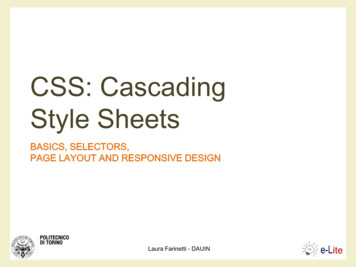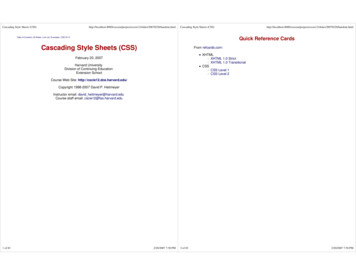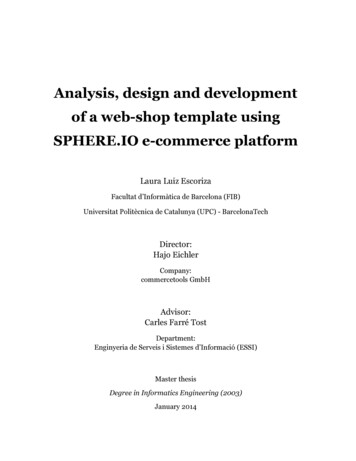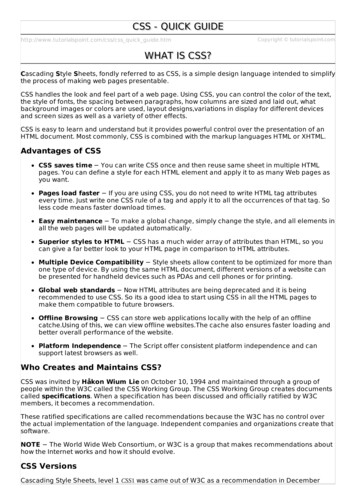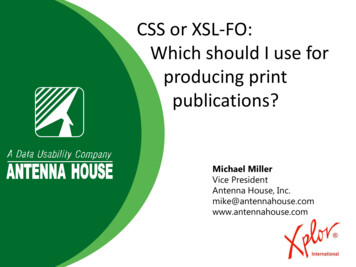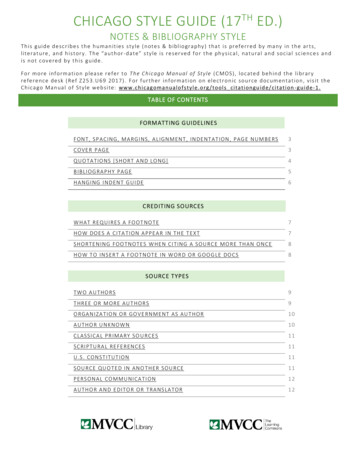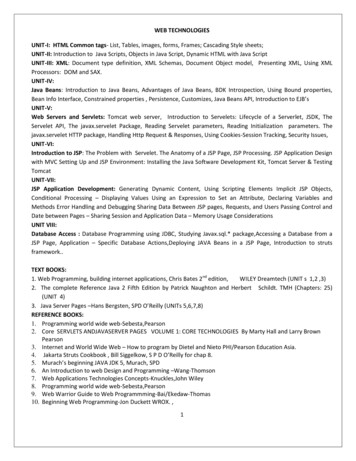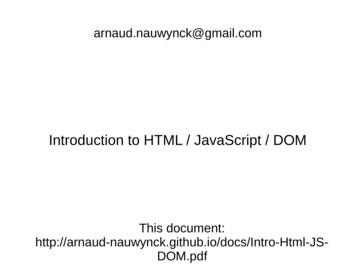
Transcription
Introduction to Cascading Style SheetsPat MorinCOMP 2405
Outline Motivation for CSS How to use CSS in your documents Formatting text with CSS– Font properties– Text properties Formatting lists with CSS Summary2
HTML HTML (when used correctly) describes thedifferent parts of a document– Paragraphs, section headings, quotes, images, . HTML (when used correctly) does not describethe formatting of a document HTML is a logical markup language not a physicalmarkup language HTML was designed to be rendered on a widevariety of devices– Graphical web browsers, text terminals, screen readers, .3
CSS CSS (Cascading Style Sheets) is for theformatting side of the Web CSS describes how rendered HTML documentsshould look CSS considers the physical and visual display ofthe document (the Style)4
Advantages of CSS The use of CSS separates document layout fromdocument content– Different people can be responsible for the two parts– Document author can focus on content– Graphic designer can focus on layout A single file can control the look of an entire website– Easy to modify look of web site without affecting its contents– Easy to obtain a consistent look (the R in CRAP) If done correctly, documents degrade gracefullyon platforms that don't support visual formatting5
Disadvantages of CSS More to learn– CSS is powerful but complex Not fully supported on some browsers– Even some modern browsers are not fully CSS 2 compliant The formatting is separated from the document– Makes it hard to write a document and format itsimultaneously6
How to Write a Document1.Decide what you want to write First and foremost the content of the document is importantDecide on the logical structure of the document2.Write it Write the document contentMarkup the document's logical structure3.Format it Use CSS to do formattingAdd other formatting-specific data (e.g., navigation)Points 1 and 2 should take the majority of thetime7
Using CSS There are three ways to use CSS External Style Sheets– Uses the LINK tag (in the document HEAD) link rel ”stylesheet” href ”./morin.css”type ”text/css” Inline Style Sheets– The STYLE tag (in the document HEAD) style type ”text/css” /* CSS information goes here */ /style 8
Using CSS (Cont'd) Inline STYLE Attributes– The STYLE attribute (within another HTML tag) a style ”font-size: 10pt;” href ”xsk.html” Don't use these– Gives the disadvantages of CSS without the most importantadvantages9
Simple CSS An Inline CSS example that modifies some of thecommon HTML tags style type ”text/css” h1 {font-size:12pt;font-family: “Luxi Sans”, sans-serif;font-weight: bold;}p {font-size:12pt;font-family: “Luxi Serif”, serif;} /style 10
CSS with Class (Almost) all HTML tags can have an optionalCLASS attribute This works nicely in conjunction with CSS: style type ”text/css” p.blogentry {font-size:12pt;font-family: “Luxi Serif”, serif;} /style . p class ”blogentry” Today was the best day ever . /p 11
CSS with IDs Similarly, almost all HTML tags can have an IDattribute: style type ”text/css” #menubar {font-size:12pt;font-family: “Luxi Serif”, serif;} /style . ul id ”menubar” li Item 1 /li . /ul 12
Notes on CLASS and ID Use CLASS when a document contains (or maycontain) many items of this type– E.g.: blogEntry, nameList, properName Use ID when a document can only contain oneitem of this type– E.g. pageTitle, mainNavigationBar Choose CLASS and ID names wisely– Good: a id ”properName” Pat Morin /a – Bad: a id ”blueunderlinenowrap” Pat Morin /a 13
The DIV and SPAN tags HTML has 2 tags, DIV and SPAN, that arespecifically used with CSS and CLASS and IDattributes A DIV tag contains a block of text– Like a paragraph, section heading, or title A SPAN tag contains a short piece of text within ablock– Like a proper name, or a dollar amount14
Example of DIV and SPAN div class ”mainDocument” On his way to school, span class ”properName” Uncle Rico /span stopped at the local groceteria and spent span class ”money” 4.55 /span on milk,bread, and honey. /div div class ”about” This document was written by span class ”properName” Pedro Sanchez /span on span class ”date” Jan. 9th, 2007 /span . /div 15
Typeface: font-family Consists of a comma-separated list of font namesh1 { font-family: “Times New Roman”,“ Luxi Serif”,“ DejaVu LGC Serif”,serif;} Not all fonts are available on all systems– Browser will try fonts in order that they are specified Always make the last option one of the genericfonts: serif, sans-serif, cursive, fantasy, ormonospace16
Font Size: font-size Specified in one of the CSS size units––––1em is the width of a letter m (relative to surrounding text)1pt is a standard typographic point (1/72 inches)1px is one screen pixelKeywords: xx-small, x-small, small, medium, large,x-large, xx-large are browser dependant– Percentages: XXX% relative to the surrounding code Points and pixels are extremely accurate but notresizeableh1 { font-size: 200%; }h2 { font-size: large; }h3 { font-size: medium; }17
Bold Fonts: font-weight Can be one of normal, bold, bolder,lighter, 100, 200, ., 900h1 { font-weight: bold;font-size: 200%;}h2 { font-weight: bold;font-size: medium;}18
The Font Style: font-style Can be one of normal, italic, or oblique An italic font is usually slanted and maybe hassome curls added An oblique font is a skew transformation of aregular font (not well supported)em { font-style: italic; }h1 { font-family: sans-serif;font-weight: bold;font-style: italic;}19
Other Font Properties Use font-variant for producing small caps Use font-stretch to expand or condense afont Use font as a shorthand to set all font propertiesat onceh1 { font: italicsmall-capsbold12ptsans-serif;}20
Text Properties: color Can be a color name, a rgb value, or ahexadecimal value 147 color names are at– http://www.w3schools.com/css/css colornames.asp/*H1H2H3Make all{ color:{ color:{ color:headings pure red */red; }rgb(255,0,0); }#ff0000; }21
Text Properties: background The background property specifies thebackground color and/or image background-color specifies a color (named,RGB, or hex) background-image, background-position,background-repeat, and/or backgroundattachment to specify a background image Usually used on the body tag22
Text Properties: text-align Determine which side of the page (or containingbox) that text lines up with Can be one of left, right, center, orjustifyh1 { text-align: center; }p { text-align: left; }23
Text Properties: text-decoration Add some decoration to the text Can be one of none, underline, overline,line-through, or blink Treat blink like a contagious diseaseh1 { text-decoration: underline; }a { text-decoration: none; }24
Text Properties: text-indent Specifies a length by which the first line of textshould be indented Length can be measured in a relative unit– em: the font-size of the current font (width of a letter m)– ex: the x-height of the current font (height of a letter x)– px: one screen pixel Or an absolute unit– Inches (in) centimeters (cm) millimeters (mm), points (pt), orpicas (pc) 1pt (1/72)in and 1pc 12ptP { text-indent: 5em; }25
Text Properties: text-transform Can actually transform the text Can be one of––––none: don't do anything to the textcapitalize: Start each word with an uppercase letteruppercase: Make everything uppercase (allcaps)lowercase: Make everything lowercaseh1 { font-size: large;text-transform: capitalize;}h2 { font-size: normal;text-transform: uppercase;}26
Text Properties: white-space Defines how white space (space, tabs, carriagereturns) is handled Can be one of– normal: Normal formatting, wrap at white space, mergemultiple whitespace– pre: treat as preformatted text– nowrap: don't wrap at whitespacea.properName { white-space: nowrap; }27
Other Text Properties direction: Sets the text direction line-height: Sets the distance between lines letter-spacing: Sets the space betweencharacters text-shadow: Make a colored text shadow unicode-bidi– Allows english blocks to flow left-to-right and Arabic blocksflow right-to-left on the same page word-spacing: Sets the space between words These probably should not be used unless youknow a lot about typesetting.28
CSS and Lists Several properties are specific to lists and listitems list-style-image: sets an image to use as the bulletmarker list-style-position: controls where the bulletappears list-style-type: specifies what kind of bullet to use– none, disc, circle, square, decimal, decimal-leading-zero,lower-roman, upper-roman, lower-alpha, upper-alpha, lowergreek, lower-latin, upper-latin, hebrew, armenian,,georgian,ul.menu li { list-style-type: none; }cjk-ideographic, hiragana, katakana, hiragana-iroha,katakana-iroha29
CSS Lookup We can specify styles that apply to tags oridentifiers only when contained in other tagsul.menu { padding: 0; }ul.menu li { text-decoration: none; }. ul class ”menu” li Menu item1 /li li Menu item2 /li /ul 30
CSS and the A Tag CSS has several options for the A tag– A:link defines the style for normal unvisited links– A:visited defines the style for links that have already beenvisited in the past– A:active defines the style for links after the user clicks onthem (usually while the next page loads)– A:hover defines the style for links when the mouse pointer ishovering over them A:hover is useful for making things that look likemenus31
Summary CSS provides fine-grained control over– fonts– text– the display of lists The CSS lookup mechanism allows us to applystyles to tags that only appear within other tags In practice, many authors ignore most HTML tagsother than DIV and SPAN32
7 How to Write a Document 1.Decide what you want to write First and foremost the content of the document is important Decide on the logical structure of the document 2.Write it Write the document content Markup the document's logical structure 3.Format it Use CSS to do formatting Add other formatting-specific data (e.g., n
